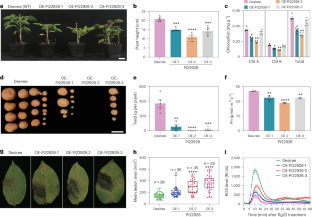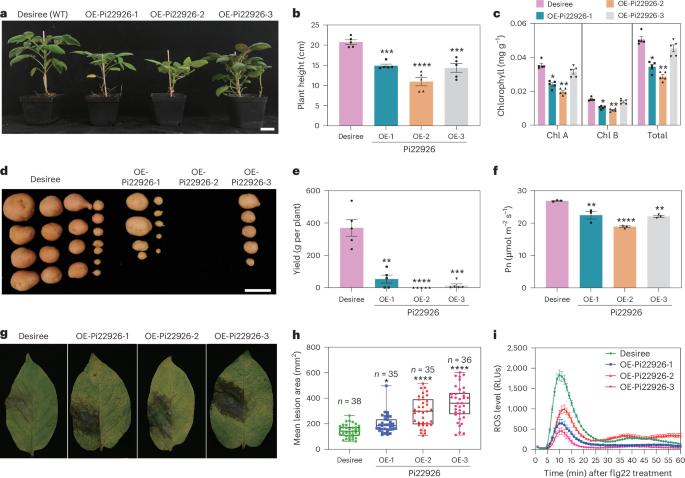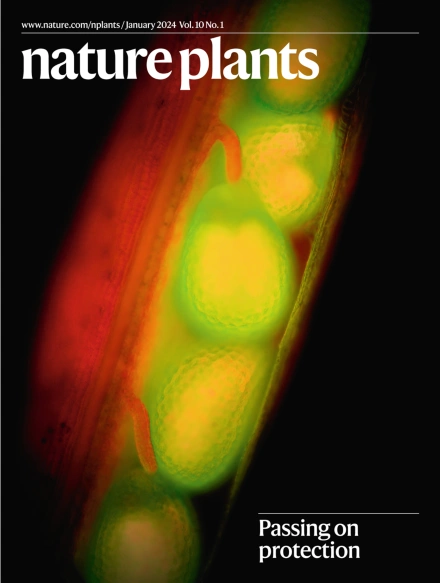叶绿体伸长因子同时促进产量和防御,打破了生长与免疫之间的平衡
IF 13.6
1区 生物学
Q1 PLANT SCIENCES
引用次数: 0
摘要
叶绿体调控植物发育和免疫。在此,我们报告了马铃薯叶绿体伸长因子 StTuA 和 StTuB,它们是 Phytophthora infestans RXLR 效应子 Pi22926 的靶标,对免疫和生长有积极的调节作用。表达 Pi22926 或沉默 TuA/B 的植物对 P. infestans 的易感性增加,光合作用、植物生长和块茎产量下降。与此相反,StTuA/B 的过表达会降低易感性,提高叶绿体源性活性氧的产生,并通过增强叶绿体蛋白的翻译来提高光合作用和马铃薯块茎的产量。Pi22926 的另一个植物靶标 StMAP3Kβ2 与 StTuB 相互作用,使其磷酸化,促进其转译到叶绿体中。然而,Pi22926 会削弱 StTuB 与 StMAP3Kβ2 的结合和磷酸化。这减少了 StTuB 向叶绿体的转位,导致其在细胞质中由蛋白酶体介导的周转。我们发现了病原体效应物通过破坏叶绿体关键功能来抑制免疫的新机制。这项工作表明,StTuA/B 打破了生长-免疫权衡,既促进了抗病性,又提高了产量,揭示了叶绿体生物学在作物育种中的巨大潜力。本文章由计算机程序翻译,如有差异,请以英文原文为准。


Chloroplast elongation factors break the growth–immunity trade-off by simultaneously promoting yield and defence
Chloroplasts regulate plant development and immunity. Here we report that potato chloroplast elongation factors StTuA and StTuB, targeted by Phytophthora infestans RXLR effector Pi22926, positively regulate immunity and growth. Plants expressing Pi22926, or silenced for TuA/B, show increased P. infestans susceptibility and decreased photosynthesis, plant growth and tuber yield. By contrast, StTuA/B overexpression reduces susceptibility, elevates chloroplast-derived reactive oxygen species production and increases photosynthesis and potato tuber yield by enhancing chloroplast protein translation. Another plant target of Pi22926, StMAP3Kβ2, interacts with StTuB, phosphorylating it to promote its translocation into chloroplasts. However, Pi22926 attenuates StTuB association with StMAP3Kβ2 and phosphorylation. This reduces StTuB translocation into chloroplasts, leading to its proteasome-mediated turnover in the cytoplasm. We uncover new mechanisms by which a pathogen effector inhibits immunity by disrupting key chloroplast functions. This work shows that StTuA/B break the growth–immunity trade-off, promoting both disease resistance and yield, revealing the enormous potential of chloroplast biology in crop breeding. Enhanced expression of chloroplast elongation factors StTuA/B increases potato disease resistance and photosynthesis, while oomycete effector Pi22926 inhibits their entry into the chloroplasts by disrupting their phosphorylation by StMAP3Kβ2.
求助全文
通过发布文献求助,成功后即可免费获取论文全文。
去求助
来源期刊

Nature Plants
PLANT SCIENCES-
CiteScore
25.30
自引率
2.20%
发文量
196
期刊介绍:
Nature Plants is an online-only, monthly journal publishing the best research on plants — from their evolution, development, metabolism and environmental interactions to their societal significance.
 求助内容:
求助内容: 应助结果提醒方式:
应助结果提醒方式:


